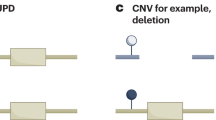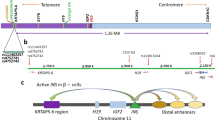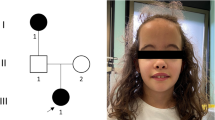Relaxation of insulin-like growth factor II gene imprinting implicated in Wilms' tumour (original) (raw)
- Letter
- Published: 22 April 1993
- Michael R. Eccles1,
- Jenny Szeto1,
- Leslie A. McNoe1,
- Kankatsu Yun1 na1,
- Marion A. Maw1,
- Peter J. Smith1 na2 &
- …
- Anthony E. Reeve1 na3
Nature volume 362, pages 749–751 (1993)Cite this article
- 677 Accesses
- 6 Altmetric
- Metrics details
Abstract
GENOMIC imprinting has been implicated in the onset of several embryonal tumours but the mechanism is not well understood1–3. Maternal chromosome 11p15 loss of heterozygosity4 and paternal chromosome 11 isodisomy5,6 suggest that imprinted genes are involved in the onset of Wilms' tumour and the Beckwith–Wiedemann syndrome. The insulin-like growth factor II (IGF2) gene located at 11pl5.5 has been put forward as a candidate gene as it is maternally imprinted (paternally expressed) in the mouse7, and is expressed at high levels in Wilms' tumours8,9. We report here that the IGF2 gene is expressed from the paternal allele in human fetal tissue, but that in Wilms' tumour expression can occur biallelically. These results provide, to our knowledge, the first evidence that relaxation of imprinting may play a role in the onset of disease and suggest a new genetic mechanism involved in the development of cancer.
This is a preview of subscription content, access via your institution
Access options
Subscribe to this journal
Receive 51 print issues and online access
$199.00 per year
only $3.90 per issue
Buy this article
- Purchase on SpringerLink
- Instant access to full article PDF
Prices may be subject to local taxes which are calculated during checkout
Additional access options:
Similar content being viewed by others

Imprinting disorders
Article 29 June 2023


References
- Wilkins, R. J. The Lancet i, 329–331 (1988).
Article Google Scholar - Reik, W. & Surani, M. A. Nature 338, 112–113 (1989).
Article CAS ADS Google Scholar - Ponder, B. Nature 340, 264 (1989).
Article CAS ADS Google Scholar - Junien, C., Van Heyningen, V., Evans, G., Little, P. & Mannens, M. Genomics 12, 620–625 (1992).
Article CAS Google Scholar - Henry, I. et al. Nature 351, 665–667 (1991).
Article CAS ADS Google Scholar - Grundy, P. et al. The Lancet 338, 1079–1080 (1991).
Article CAS Google Scholar - DeChiara, M., Robertson, E. J. & Efstratiadis, A. Cell 64, 849–859 (1991).
Article CAS Google Scholar - Reeve, A. E., Eccles, M. R., Wilkins, R. J., Bell, G. I. & Millow, L. J. Nature 317, 258–260 (1985).
Article CAS ADS Google Scholar - Scott, J. et al. Nature 317, 261–262 (1985).
ADS Google Scholar - Tadokoro, K., Fujii, H., Inoue, T. & Yamada, M. Nucleic Acids Res. 19, 6967 (1991).
Article CAS Google Scholar - DeChiara, T. M., Efstradiadis, A. & Robertson, E. J. Nature 345, 78–80 (1990).
Article CAS ADS Google Scholar - Little, M., van Heyningnen, V. & Hastie, N. Nature 351 609–610 (1991).
Article CAS ADS Google Scholar - Olshan, A. F. Cander Genet. Cytogenet. 21, 303–307 (1986).
Article CAS Google Scholar - Reik, W. Trends Genet. 5, 331–336 (1989).
Article CAS Google Scholar - Moore, T. & Haig, D. Trends Genet. 7, 45–49 (1991).
Article CAS Google Scholar - Ferguson-Smith, A. C., Cattanach, B. M., Barton, S. C., Beechey, C. V. & Surani, M. A. Nature 351, 667–670 (1991).
Article CAS ADS Google Scholar - Koufos, A. et al. Am. J. Hum. Genet. 44, 711–719 (1989).
CAS PubMed PubMed Central Google Scholar - Aleck, K. A. & Hadro, T. A. Am. J. med. Genet. 33, 155–160 (1989).
Article CAS Google Scholar - Moutou, C., Junien, C., Henry, I. & Bonaiti-Pellie, C. J. Med. Genet. 29, 217–220 (1992).
Article CAS Google Scholar - Vijoen, D. & Ramesar, R. J. med Genet. 29, 221–225 (1992).
Article Google Scholar - Sambrook, J., Fritsch, E. F. & Maniatis, T. Molecular Cloning: A Laboratory Manual 2nd edn (Cold Spring Harbor Laboratory Press, New York, 1989).
Google Scholar
Author information
Author notes
- Kankatsu Yun: Department of Pathology, University of Otago, Dunedin, New Zealand
- Peter J. Smith: Department of Pathology, University of Queensland, Herston, Queensland 4006, Australia
- Anthony E. Reeve: To whom correspondence should be addressed.
Authors and Affiliations
- Cancer Genetics Laboratory, Department of Biochemistry, University of Otago, Dunedin, New Zealand
Osamu Ogawa, Michael R. Eccles, Jenny Szeto, Leslie A. McNoe, Kankatsu Yun, Marion A. Maw, Peter J. Smith & Anthony E. Reeve
Authors
- Osamu Ogawa
You can also search for this author inPubMed Google Scholar - Michael R. Eccles
You can also search for this author inPubMed Google Scholar - Jenny Szeto
You can also search for this author inPubMed Google Scholar - Leslie A. McNoe
You can also search for this author inPubMed Google Scholar - Kankatsu Yun
You can also search for this author inPubMed Google Scholar - Marion A. Maw
You can also search for this author inPubMed Google Scholar - Peter J. Smith
You can also search for this author inPubMed Google Scholar - Anthony E. Reeve
You can also search for this author inPubMed Google Scholar
Rights and permissions
About this article
Cite this article
Ogawa, O., Eccles, M., Szeto, J. et al. Relaxation of insulin-like growth factor II gene imprinting implicated in Wilms' tumour.Nature 362, 749–751 (1993). https://doi.org/10.1038/362749a0
- Received: 20 January 1993
- Accepted: 10 March 1993
- Issue Date: 22 April 1993
- DOI: https://doi.org/10.1038/362749a0